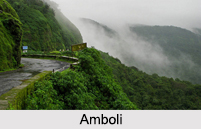 Hills stations of Maharashtra are beautiful and at the same time appealing to the tourists and visitors for the landscape beauty and the soothing mountain climate. These hill stations are located on the Western Ghats Mountain Range in India. Some of the popular destinations are Matheran, Lonavla, Lavasa, Khandala, Mahabaleshwar, Panchgani, Bhandardara, Malshej Ghat, Amboli, Chikhaldara Panhala, Sawantwadi, Toranmal and Jawahar.
Hills stations of Maharashtra are beautiful and at the same time appealing to the tourists and visitors for the landscape beauty and the soothing mountain climate. These hill stations are located on the Western Ghats Mountain Range in India. Some of the popular destinations are Matheran, Lonavla, Lavasa, Khandala, Mahabaleshwar, Panchgani, Bhandardara, Malshej Ghat, Amboli, Chikhaldara Panhala, Sawantwadi, Toranmal and Jawahar.
Amboli, Sindhudurg District
Amboli is located on the Sahyadri Hills (690 meters from the sea level) before the beginning of the coastal plains.
 Bhandardara, Ratangad Fort
Bhandardara, Ratangad Fort
Bhandardara is popular for the Arthur Lake, Ratangadh Fort, prehistoric temple of Amriteshwar, Wilson Dam, and Radha Falls.
Chikhaldara Hills, Amravati district
Chikhaldara Hills has its reference from Mahabharata, now turned into a popular tourism destination. This place is popular for the coffee plantation and Melghat Tiger Project.
Igatpuri, Nashik District
Igatpuri has the tourism attractions like Bhatsa river valley, Amruteshwar Temple, Tringalwadi fort, Ghatandevi temple and Dhammagiri Meditation Centre. This place is ideal for camel riding.
Jawhar, Palghar district
Jawhar is a hilly town, famous for its Warli paintings. It was once the part of tribal rule in India.
Khandala, Lonavala and Karla, Western Ghats Mountain Range
These twin hill stations are positioned on the slopes of the Sahyadri Hills. Mumbai - Pune Highway acts as a connecting point to reach there. Karla is about 12 km away from Lonavala, noted for the Karla Caves.
Mahabaleshwar, Satara District
Mahabaleshwar is known as the "Queen of Hills", because of the presence of Krishnabai temple, 3 Monkey Point, Arthur"s Seat, Venna Lake, Kate`s Point, Lingmala Waterfalls and Wilson Hills (Gujarat).
Malshej Ghat, Pune
 Malshej Ghat is popular for the flamingos during the advancing monsoon and retreating monsoon. The dense forest adds to the beauty of its country side. Shivneri Fort, Pimpalgaon Joga Dam, Harishchandragad, and Malshej Falls are the popular attractions here.
Malshej Ghat is popular for the flamingos during the advancing monsoon and retreating monsoon. The dense forest adds to the beauty of its country side. Shivneri Fort, Pimpalgaon Joga Dam, Harishchandragad, and Malshej Falls are the popular attractions here.
Matheran, Raigad district
This is a place where people can effort to take in fresh air. The two hours toy train ride to this 800m high hill station is an experience of unforgettable adventure.
Panchgani, Satara district
Panchgani has got its name from the 5 hills surrounding it. The breathtaking view of Krishna River and Mapro Gardens are the cynosure in Panchgani.
Panhala, Kolhapur district
Once it was the fort city of Maratha Empire, now converted into a hill station offering the mountain ranges with magnificent climate.
Toranmal, Nandurbar district
Toranmal offers the quiet and serene beauty of nature at an altitude of 1461m above the sea level.
Karjat, Raigad district
Karjat is noted for the adventure sports like river rafting, hiking, trekking and rock climbing. This place is popular for leisure tourism for the presence of Peth Fort, Kondana Caves, Bhor Ghat and Ulhas River.



















